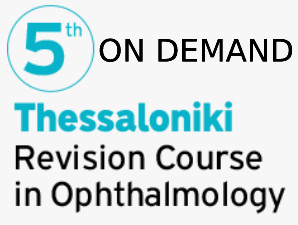Presented by: Dimitris Sakellaris MD
Edited by: Penelope Burle de Politis MD

The surgical correction of refractive errors has breached the limits of the corneal territory in the past few years. As excimer laser-based surgery keeps evolving through high-definition platforms and customized treatments in its various modalities, there is only a certain amount of ablation that the corneal tissue can take. In cases of high ametropia, the gray zone between the patients’ wish to see without glasses and how far the refractive surgeon can go without altering the shape of the cornea beyond its functional optic properties demanded solutions. While clear lens extraction remains an off-label practice still awaiting FDA approval, the search for less controversial, undebatably safer techniques has led us to what is now the last word in intraocular refractive surgery for phakic eyes, the Implantable Collamer Lens (ICL).
A particular type of posterior chamber phakic intraocular lens (IOL), ICLs not only overturn the risks of anterior chamber phakic IOLs but also pose a benefit to the follow-up of glaucoma-prone patients by not altering corneal pachymetry, a major limitation of the corneal procedures. Moreover, ICLs have the advantage of being virtually invisible to the naked eye, just like a conventional extraocular contact lens, and constituting a totally reversible operation, allowing for future reapproach in case of refractive needs or media transparency changes. The corrective spectrum of ICLs merges that of soft contact lenses, covering high spherical ametropia, moderate astigmatism, and even presbyopia.
Nevertheless, ICLs represent one more tool in the hall of strictly elective surgeries committed to results in a world of progressively demanding individuals and circumstances. In order to minimize complications and ensure patient satisfaction, careful preoperative assessment is indispensable. Characteristics of the eye that may be contraindications to ICL, like low anterior chamber depth and a narrow angle, are better analyzed by anterior segment optical coherence tomography (AS-OCT). Aside from IOL power calculation, an ideal lens size is required to create a proper “vault”, the space between the ICL and the crystalline lens. As is the case with any refractive surgery, postoperative routine evaluations are recommended for early detection and adequate management of potential issues related either to the implant or to the ametropic eye itself.
In this video, recorded in the main operating room of the Ophthalmica Eye Institute in Thessaloniki, Greece, Dr. Dimitrios Sakellaris (MD), specialist in cornea and anterior segment surgery, performs a toric-ICL Implantation on the left eye of a 36-year-old male with 13 diopters of myopia and 2 diopters of astigmatism. The patient was intolerant to any contact lens use. The surgical steps and timing in the video are as follows: cartridge nozzle fill with BSS and viscoelastic to facilitate insertion (00:10); gentle ICL placement into the cartridge minding correct vault orientation (01:10); ICL grasp using special forceps (02:25); pulling away the cartridge without pulling the ICL (02:35); cartridge load onto the injector (02:48); 0°-180° axis mark for toric ICL (03:05); sideport creation with a tilt towards the plane of action for better manipulation (03:25); viscoelastic injection into the anterior chamber (04:00); main 2.2 mm self-sealing incision temporally (04:20); careful ICL insertion into the anterior chamber (04:50); haptics placement in the sulcus on both ends (05:45); fine-tuning of ICL axis orientation (06:20); viscoelastic removal through bimanual irrigation-aspiration (07:32); hydration of entry sites (09:15). The procedure ends with a successfully implanted toric phakic ICL and total neutralization of the high myopia (09:52).
“You either have to be part of the solution, or you’re going to be part of the problem.” – Eldridge Cleaver
Video:


